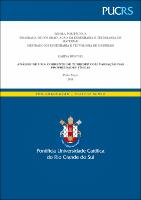| Share record |


|
Please use this identifier to cite or link to this item:
https://tede2.pucrs.br/tede2/handle/tede/8019| Document type: | Dissertação |
| Title: | Análise de uma corrente de turbidez com variação das propriedades físicas |
| Author: | Ruschel, Karina  |
| Advisor: | Silvestrini, Jorge Hugo |
| Abstract (native): | Com o objetivo de determinar qual o efeito do da variação do coeficiente de viscosidade dinâmica e da velocidade de queda num escoamento com sedimentos, o presente trabalho faz uso de uma metodologia numérica computacional e do conceito de corrente de gravidade. Por meio de duas abordagens numéricas distintas, compara as vantagens de utilizar uma abordagem do tipo ILES com DNS, afim de reduzir o tempo computacional e ainda manter grande parte do efeito da física no problema. São comparados quatro casos distintos, com e sem propriedades variáveis, totalizando oito simulações. Para verificar o código, foi simulado um caso (CASO 0) baseado no artigo de Espath et al. (2013) variando o coeficiente de viscosidade dinâmica e a velocidade de queda utilizando uma metodologia DNS. Para o CASO I, foi verificado o efeito da metodologia ILES, com os mesmos parâmetros do CASO 0. Por fim, para aumentar a concentração e, por consequência, o número de Reynolds, os CASOS II e III utilizaram parâmetros de sedimentos como carvão e pume na aproximação de Boussinesq. Foi observado que o efeito da velocidade de queda variável auxilia na redução da velocidade da posição da frente e mantém mais material em suspensão por mais tempo, sendo tal efeito observado em casos experimentais, o que demonstra a aproximação ainda maior das simulações numéricas com casos reais. |
| Abstract (english): | The present work uses a numerical computational methodology and the concept of gravity current to determine the effect of the variable properties on a sediment flow. Through two different numerical approaches, it compares the advantages of using an ILES or DNS in order to reduce computational time and still keep physics of the problem. Four different cases are compared, with and without variable properties, totaling eight simulations. To verify the code a case (CASE 0) was simulated based on the article of cite espath13 by varying the coefficient of dynamic viscosity and the fall velocity using a DNS methodology. For CASE I, the effect of the ILES methodology was verified with the same parameters of CASE 0. Finally, to increase the concentration and the Reynolds number, CASES II and III use sediment parameters such as coal and pume in Boussinesq approach. It was observed that the effect of the variable fall velocity helps to reduce the velocity of the front and maintains more material in suspension for longer time periods, being this effect observed in experimental cases, which demonstrates the even greater approximation of numerical simulations with cases real. |
| Keywords: | Viscosidade Variável Corrente de Gravidade Corrente de Turbidez Velocidade de Queda Variável ILES DNS Simulação Numérica Computacional Variable Viscosity Turbiduty Current Gravity Current Variable Falling Velocity ILES DNS Numerical Computational Simulation |
| CNPQ Knowledge Areas: | ENGENHARIAS |
| Language: | por |
| Country: | Brasil |
| Publisher: | Pontifícia Universidade Católica do Rio Grande do Sul |
| Institution Acronym: | PUCRS |
| Department: | Escola Politécnica |
| Program: | Programa de Pós-Graduação em Engenharia e Tecnologia de Materiais |
| Access type: | Acesso Aberto |
| Fulltext access restriction: | Trabalho não apresenta restrição para publicação |
| URI: | http://tede2.pucrs.br/tede2/handle/tede/8019 |
| Issue Date: | 28-Mar-2018 |
| Appears in Collections: | Programa de Pós-Graduação em Engenharia e Tecnologia de Materiais |
Files in This Item:
| File | Description | Size | Format | |
|---|---|---|---|---|
| main_old.pdf | KARINA_RUSCHEL_DIS | 8.62 MB | Adobe PDF |  Download/Open Preview |
Items in DSpace are protected by copyright, with all rights reserved, unless otherwise indicated.




